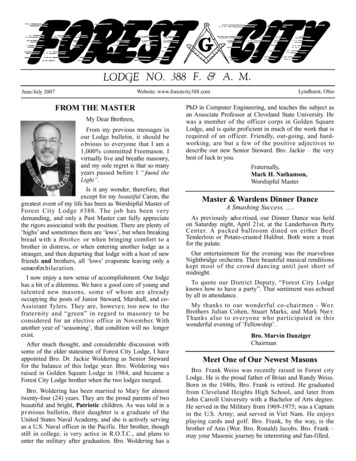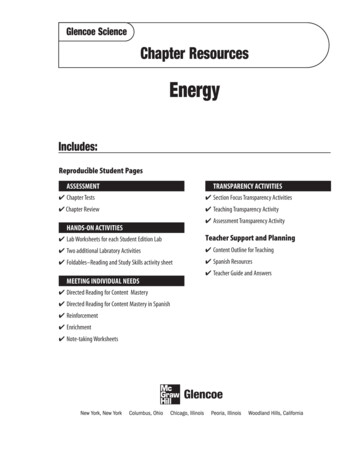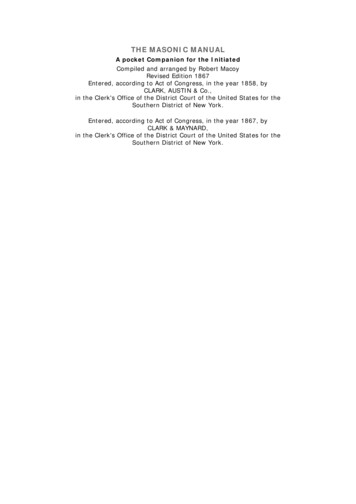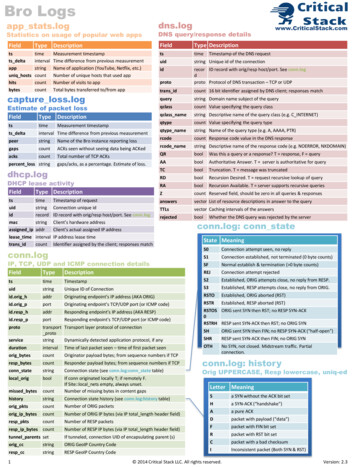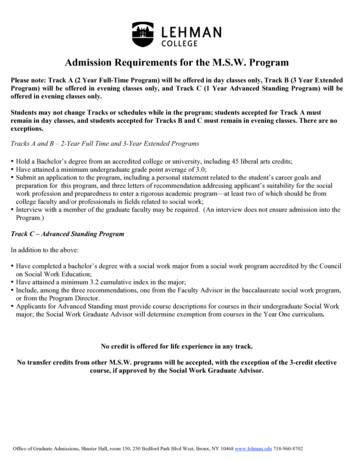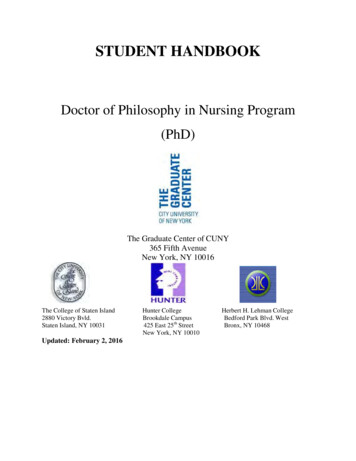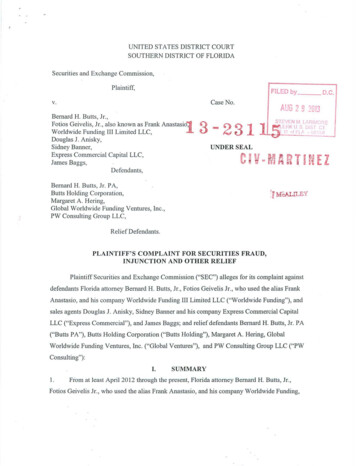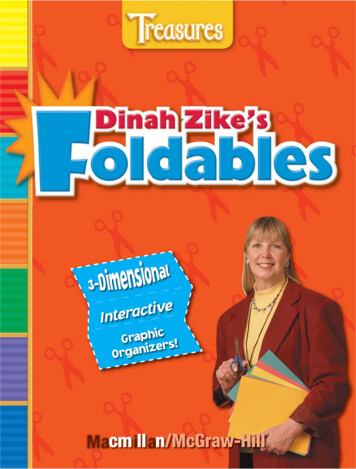
Transcription
evitcarIntecGraphi rs!zeOrgani
veitcareIntcGraphi rs!zeOrgani
APublished by Macmillan/McGraw-Hill, of McGraw-Hill Education, a division of The McGraw-Hill Companies, Inc.,Two Penn Plaza, New York, New York 10121.Copyright by Macmillan/McGraw-Hill. All rights reserved. The contents, or parts thereof, may be reproduced in print formfor non-profit educational use with Treasures, provided such reproductions bear copyright notice, but may not be reproducedin any form for any other purpose without the prior written consent of The McGraw-Hill Companies, Inc., including, but notlimited to, network storage or transmission, or broadcast for distance learning.Printed in the United States of America1 2 3 4 5 6 7 8 9 005 10 11 10 09 08 07
TMWhat are Foldables ?Foldables are multi-dimensional graphicorganizers that can be used forskills reinforcement, practice,and/or information organizing.TMWhy use Foldables ?Not only do Foldables reinforceskills and strategies essentialfor reading success, theyprovide a kinesthetic toolfor organizing andanalyzing learning.Foldables3
Dear Teacher,A Foldable is a three-dimensional, studentmade (and/or teacher-made) interactivegraphic organizer based upon a skill. Makinga Foldable gives students a fast, kinestheticactivity that helps them organize and retaininformation either before, during, or afterreading. In this section of the Teacher’sResource Book, you will find instructions formaking Foldables, as well as ideas on how touse them to reinforce and practice phonics, vocabulary, spelling,and comprehension skills.In this section, you will find Foldables to help you replace photocopied activity sheets with student-generatedprint present content and skills in a clear, visual, kinesthetic format incorporate the use of such skills as comparing andcontrasting, recognizing cause and effect, and findingsimilarities and differences assess student progress and learning levels immerse students in new and previously learned vocabularyand reading skills teach students unique ways to make study guides andpractice materials, and provide students with a sense of ownership in their learning.I am excited to hand these Foldable ideas and activities over toyou and your students. Have fun using, adding to, and amendingthem to meet individual needs.Sincerely,4Foldables
Creating and Storing FoldablesTMAs you use the Foldables outlined in this Teacher’s Resource Book,discuss with students how they can adapt them to make their ownFoldables learning and study aids. Teach students to write—titles,vocabulary words, concepts, skills, questions, main ideas—on thefront tabs of their Foldables. By doing this, key concepts are viewedevery time a st udent looks at a Foldable. Foldables help studentsfocus on and remember the information presented without beingdistracted by other print. Remind students to write more specificinformation—supporting ideas, examples of a concept, definitions,answers to questions, observations—under the tabs.Turn one-gallon freezer bags into student portfolios and storagecontainers for Foldables.Cut the bottom corners off each bag so they won’thold air and will stack and store easily.Write student names across the top of the plasticportfolios with a permanent marker and cover thewriting with two-inch clear tape to keep it fromwearing off.Place a piece of cardboard inside each portfolio togive it strength and to act as a divider.Store Foldables in a giant laundry soap box. Or,students can carry their portfolios in a three-ringbinder if you place a strip of two-inch clear tapealong one side and punch three holes through thetaped edge.Foldables5
TMin this sectionBasic Shapes. 7Foldables at a Glance. 8Answer Mitt (with student copying master) . 10Picture Frame . 12Shutter . 14Four Door . 16Pocket. 18Standing Cube. 20Layered Book . 22Large Word Study Book. 24Matchbook . 26Two- and Three-tab . 28Four- and Eight-tab. 32Accordion Book . 36Pyramid . 38Folded Tables and Charts . 40Foldables Correlated to Reading Skills. 426Foldables
Basic Shapesby Dinah ZikeThese figures illustrate the basic folds that are referred to throughout the followingsection of this book.Taco FoldHot Dog FoldHamburger FoldBurrito FoldValley FoldShutter FoldMountain FoldFoldables7
Foldables At a GlanceTMby Dinah ZikePicture FrameFoldableAnswer Mitt FoldableShutter Foldablethehas wolfteetbighPocket Foldableolfthe w gryis hunStanding Cube Foldable8Four-Door FoldableLayered Book FoldableLarge Word StudyBook FoldableFoldables
Two-Tab FoldableMatchbook Foldablec anc anaThree-Tab FoldableFour-Tab FoldableEight -TabFoldableAccordion FoldablePyamid Foldable.VMUJQMF .FBOJOH8PSET8PSE %FGJOJUJPO %FGJOJUJPOFolded Tablesand ChartsFoldables9
Answer Mitt FoldableTMby Dinah ZikeMaterials: Copying Master on page 39 scissors glue stick colored paperDirections:1. Copy the pattern onto colored paper.2. Have children fold the mitt so the fingertips touch each other.3. Then have children cut out the mitt shape.4. Have them cut along the fold an inch or so in from the bottomedge. They may then fold up the flaps.5. To complete the mitt, have children glue the thumbs of the mitttogether so a pocket is formed. They may also glue the edgesof the wrist flaps to make holders for letter cards.CUUsing the Answer Mitt FoldableTMFor any skills instruction, children can use the mitt to answerquestions that have two possible responses. The mitt can be usedwith letter cards or picture cards (from pages 66 –87 of this book),yes/no cards, and word cards (from pages 90–149 of this book).When children use the Answer Mitt Foldable in whole class or smallgroup instruction, you will be better able to monitor their progress.10Foldables
Foldables11
Using the Picture Frame FoldableTMby Dinah ZikeVocabulary and Phonics/Spelling ApplicationsStudents can glue pictures or draw pictures in the frame toreinforce a vocabulary word or concept. On the inside of the book,they can write or dictate sentences about the word or concept.Comprehension ApplicationTo reinforce character study, have students illustrate a storycharacter and write or dictate sentences about the character.The same sort of activity can be done with the following skills: Setting/plot Main idea/details Retelling a sceneGrammar ApplicationHave students use the frame to illustrate a noun or a verb. Thenhave them write or dictate sentences about the word.5IF DPXFBUT HSBTT 12Foldables
Picture Frame FoldableTMby Dinah ZikeMaterials: one sheet of 8½ 11 paper in a bright color one sheet of 11 17 paper scissors glueDirections:1. Fold the 8½ 11 paper into a hotdog.2. Starting at the fold, cut a frameshape (as illustrated). Set aside.3. Fold the 11 17 paper into ahamburger.4. Glue the paper frame to the frontside of the hamburger.Foldables13
Using the Shutter FoldableTMby Dinah ZikePhonemic Awareness/Phonics/Spelling ApplicationUse the Shutter Foldable to review contractions and compound wordswith students. The outside panels can be used to demonstrate thetwo parts of the word. Students can use the middle inside panel towrite out the contraction or complete compound word.Comprehension ApplicationThere are many ways to use the Shutter Foldable to review andstudy comprehension skills. Larger paper can be used so that asmall group or a class can create one of these for literacy study.Consider having students retell or summarize the story on themiddle inside panel. Then have them use the outer panels toanalyze the following: Facts and Opinions (for nonfiction) Cause and Effect Before and After Fantasy and Reality Pros and Cons (for persuasion) Problem and Solution Compare and Contrast Phonics for Primary GradesJT OPU'BDU0QJOJPOLarge Shutter Foldables can be stored inan empty (and clean!) pizza box.14Foldables
Shutter Foldable DirectionsTMby Dinah ZikeMaterials: 8½ 11 paperDirections:1. Begin as if you are going tomake a hamburger fold, butinstead of folding the paper,pinch it to show the midpoint.2. Open the sheet. Fold both of theoutside edges in to touch the middlemark.Use this Foldable toFoldables15
Using the Four-Door FoldableTMby Dinah ZikeGrammar ApplicationUse this Foldable for information occurring in four categories. Havestudents create study guides and review grammar concepts suchas four types of sentences. They may label each door with a typeof sentence, then define each type and provide an example insideeach ion ApplicationWhen students are reading a selection, they can use this Foldableto record and store information for summarizing. Have studentswrite descriptions and include illustrations inside the four doors.Guide them to choose four categories of information. For example: who, what, when, where what, where, when, why/how character, plot, setting, conflict and resolution16XIPXIBUXIFSFXIFOFoldables
Four-Door Foldable DirectionsTMby Dinah ZikeMaterials: sheet of 11″ 17″ paper scissorsDirections:1. Make a shutter fold.2. Fold the shutter fold in half like ahamburger. Crease well.3. Open the folds and cut along the inside valley fold lines.4. These cuts will form four doors on theinside of the book.Use this Foldable toFoldables17
Using the Pocket FoldableTMby Dinah ZikeVocabulary and Phonics/Spelling ApplicationsHave students use this Foldable as a study aid. Copies of wordcards can be sorted and stored by students as they learn words.Have students label the pockets as shown below. As they study thewords, have them move the cards to the appropriate pockets.XPSEDBSET5PP&BTZ5PP)BSE VTU3JHIU5PP&BTZXPSEDBSET5PP)BSEXPSEDBSET VTU3JHIUComprehension ApplicationWhen students are comparing and contrasting ideas in a selection,they can use this Foldable to record and store information forretelling or summarizing. This works with skills such as: Fact and opinion Make and confirm predictions Cause and Effect K-W-LBV Z1SFEJDUJPOT POGJSN1SFEJDUJPOTSend this Foldable home withstudents so they can review and sortwords with family members.Heavy stock paper will improvedurability. Post the Foldable on abulletin board for use during workstation18Foldables
Pocket Foldable DirectionsTMby Dinah ZikeMaterials: one 11 17 sheet of paper glueDirections:1. Begin as if you are going to makea hot dog, but only fold over aboutthree inches.2. With the paper horizontal and thefold on the bottom, fold the rightside toward the center, trying tocover one half of the paper. Then,fold the left side over the right sideto make three sections.3. Glue the right and left edges of theoriginal fold so that three pocketsare created.Foldables19
Using the Standing Cube FoldableTMby Dinah ZikeVocabulary ApplicationUse the Foldable for developing vocabulary concepts with students.Each side of the cube can show information about a word (definition,example sentences, picture, etc.).Phonemic Awareness/Phonics ApplicationWith the class, create a Foldable for each letter ofthe alphabet. Have students help by providing thecontent for each side: words that begin or end withthe letter-sound, and handwriting models for capitaland lowercase letters.Comprehension ApplicationHave students work in small groups to createa Foldable about a story character they arestudying. Each side of the Foldable shouldillustrate or tell about character traits.4THHE WHAS OLFBIIGGTEEETTBHH DVQ DBQMJQ UJQOLF4TH E WGGRRYY NNIS HHUUGrammar ApplicationUse the Foldable to collect and share types of nouns or adjectives.The Standing Cube Foldable can beflattened for easier storage or formoving it into a display area.20Foldables
Standing Cube Foldable DirectionsTMby Dinah ZikeMaterials: two sheets of 11 17 paper glueDirections:1. Fold each sheet like a hamburger, but foldone side one-half inch shorter than theother side.2. Fold the long side over the short side onboth sheets of paper, making tabs.3. On one of the folded papers, place a smallamount of glue along the tab, next to thevalley but not in it.4. Place the non-folded edge of the secondsheet of paper square into the valley andfold the glue-covered tab over this sheet ofpaper. Press flat until the glue holds. Repeatwith the other side.5. Allow the glue to dry completely beforecontinuing. After the glue has dried, collapsethe cube flat to write or draw on each side.Foldables21
Using the Layered Book FoldableTMby Dinah ZikeVocabulary ApplicationHave students create this Foldable to help them review vocabularywords. Have them write a word on each tab and then flip the tab towrite the definition. The same thing can be done with antonyms andsynonyms.Phonics/Spelling ApplicationA review/study guide of letter sounds and word parts can be donewith this Foldable. For example: Vowels Prefixes and suffixes Base words Digraphs (th, wh, sh, ch)7PXFMTBFJPV#BTF 8PSETTUSPOHGBTU IJHITNBMMComprehension ApplicationUse the Foldable to aid in the following skills reinforcement: Character study (one tab per story character) Summarize/Retelling Generating and asking questions.PUIFS UP 5JHFST IBSBDUFS 4UVEZ8IZ EJE TIF MJLF UJHFST#JH #FBS.JEEMF #FBS4NBMM #FBS(PMEJMPDLT)PX EJE TIF DBSF GPS UIFN8IBU XBT UIF NPTU DIBMMFOHJOH8IFO EJE UIF DVCT HP UP UIF [PPStudy Skills and Grammar ApplicationsThis Foldable can be used to review/reinforce concepts studied.22Foldables
Layered Book Foldable DirectionsTMby Dinah ZikeMaterials: two sheets of 8½ 11 paper glueDirections:1. Stack two sheets of paper so that the backsheet is one inch higher than the frontsheet.2. Bring the bottom of both sheets upwardand align the edges so that all of the layersor tabs are the same distance apart.3. When all tabs are an equal distanceapart, fold the papers and crease well.4. Open the papers and glue themtogether along the valley, or innercenter fold, or staple them along themountain.If you need more layers, useadditional sheets of paper. Make thetabs smaller than one inch.Use this Foldable toFoldables23
Using the Large Word Study Book FoldableTMby Dinah ZikeVocabulary and Phonics/Spelling ApplicationsWith a small group, make a Foldable for vocabulary wordstudy/review. Display the book in a workstation for repeatedreview. The size and the format also make it easy for you andstudents to use them as lap flashcards.DBO) CAN RUN FAST 7E CAN GO HOME #AN WE GO PLAYB UFTU UP TFF IPXTPNFUIJOH XPSLTFYQFSJNFOU5IF TDJFOUJTU EJE BOFYQFSJNFOU UP TFF XIBU LJOEPG GPPE NJDF QSFGFS Students can make individual books using this Foldable.Collect and use these books through theyear. Store each large book in a labeledlegal-size folder.24Foldables
Large Word Study Book Foldable DirectionsTMby Dinah ZikeMaterials: several sheets of 11 17 paper (one sheet for each wordstudied) staplerDirections:1. Fold each sheet like a hot dog,but fold one side one inch shorterthan the other side.2. Stack the sheets so the folds areside by side.3. Staple sheets together along the tabbed end (the bottom of thepages).You can make a large word studybook as an aid for vocabulary or spelling word lists. On the front of eachtab, write a vocabulary or spelling word. Open the tab and write thedefinition and a sample sentence.Use this Foldable toFoldables25
Using the Matchbook Foldable and PortfolioTMby Dinah ZikeVocabulary ApplicationWith students, create Foldables for weekly vocabulary. Write thevocabulary word on the front. Have students write a sentence forthe inside.5IF EPHDBO KVNQ DBOPhonics/Spelling ApplicationUse the Foldable for review of phonics and/or spelling words.Hd[i LdgYh\ gV[[ZEPHEVDL \Zb\ Vci\ZciaZEPXO \nbEPMMEJOPTBVSComprehension ApplicationThis Foldable works for reinforcing skills such as: Cause and effect Making predictionsStudy Skills ApplicationIf students are studying a list such as state capitals or evenmultiplication tables, the portfolio is a great small group or wholeclass review tool.26Foldables
Matchbook Foldable and Portfolio DirectionsTMby Dinah ZikeMaterials: several sheets of 8½ 11 paper poster board scissors glueDirections:1. Fold each sheet like ahamburger, but fold it sothat one side is one inchlonger than the other side.2. Fold the one-inch tab over the short sideto form an envelope-like fold.3. Fold each hamburger in half. Cut alongthe fold line.4. Grades K-1: After the content has been added to the front andinside, post the Foldable on a bulletin board.5. Grades 2-6: Fold the posterboard like ahamburger.Foldables6. Use the small hamburgersto record information. Gluethem onto the inside of theposter board.27
Using the Two- and Three-Tab FoldableTMby Dinah ZikePhonics/Spelling ApplicationUse the Three-Tab Foldable as an alternate to Sound Boxes.Open the tabs and write a CVC word on the bottom paper sothat one letter is shown in each box. Have students practiceblending and decoding words.DPOTPOBOU WPXFM DPOTPOBOUN B OAnother option is to cut off one of the tabs so that theFoldable has two tabs. After step 4, cut off the first tab. Openthe other two tabs and write a CVC word on the bottom paperso that one letter is shown in each box. For further practicewith letter-sound blending, fold the tabs over to make anotherCVC word for decoding.Q28PATQD B QFoldables
Using the Two- and Three-Tab FoldableTMby Dinah ZikePhonics/Spelling ApplicationSeveral options adapt this Foldable for prefix, base word, and suffixstudy and practice.Use the Three-Tab Foldable to help students with word parts andsyllabication. Open the tabs and write a base word in the center.Have students practice decoding words.EJTDPWFS ZAnother option is to cut only one of the valleys (see p. 31) so thatthe Foldable has two tabs of unequal size. Open the two tabs andwrite a base word on the bottom paper so that one word part isshown in each box. For further practice with pronunciation and wordidentification, fold the tabs over to make another word.QIPOFA third option is to make a two-tab variation. Use it to compare twodifferent phonic/spelling elements such as soft c and hard c, vowelspellings, or word parts.TPGUDIBSEDDirections and diagrams appear on page 31.Foldables29
Using the Two- and Three-Tab FoldableTMcontinuedby Dinah ZikeComprehension ApplicationUse large poster board and choose a vertical or horizontalorientation to adapt the Three-Tab Foldable. Use it to create thefollowing graphic organizers:CPUI Venn DiagramHXZcZ 4DFOF Story Map4DFOF K-W-L Chart, 8 - Nonfiction text organizerDirections and diagrams appear on page 31.30Foldables
Two- and Three-Tab Foldables DirectionsTMby Dinah ZikeMaterials: one 8½ 11 sheet of paper or large poster board scissorsDirections:1. Fold the sheet like a hot dog.2. With the paper horizontal and the fold of thehot dog at the top, fold the right side towardthe center, to cover one half of the paper.3. Fold the left side over the right side to make three sections.4. Open the right and left folds. Place one handbetween the two thicknesses of paper and cutup the two valleys so there are three tabs.Options: Cut only one of the valleys so the Foldable hastwo tabs of unequal size. Use large poster board to make a Foldable on which you canrecord more information.Use this Foldable toFoldables31
Using the Four- and Eight-Tab FoldableTMby Dinah ZikePhonics/Spelling ApplicationAdapt the Four-Tab Foldable to review digraphs, blends, and vowelvariant letter-sounds. Open the tabs and write a CCVC or CVCeword on the bottom paper so that one letter is shown in each box.Have students practice blending, decoding, and identifying words.SILENT hEvQUIETPLEASED S B CC B LAnother option is to make the Foldable with three tabs. At step 3(see page 34), cut only the first and the third creases so that themiddle tab is twice the size of the other two tabs. Open all threetabs and write a word with a vowel digraph or a CVVC word on thebottom paper so that one letter is shown in each box and so that themiddle two letters will be hidden by the middle tab.E P X OOr, cut only the first and second tabs and write a word that endswith double letters or the digraph-ck.C B D L32Foldables
Using the Four- and Eight-Tab FoldableTMcontinuedby Dinah ZikeVocabulary and Phonics/Spelling ApplicationsUse the Eight-Tab Foldable to study and review spelling orvocabulary words. Have students write a word on a tab, openthe tab and draw a picture, write a definition, or write a samplesentence. Students can also do a cumulative study of one ofthe following: phonic elements such as blends and digraphs suffixes and prefixesC ANCJHDBO SF DBUC ANA EJT DBSFGVM MFTT* DBO SVO VO TIJQDBO DBUIBU NBUSBOpre- OFTTComprehension ApplicationThe Eight-Tab Foldable is an ideal tool for comparing two texts.Have students use the tabs to compare and contrast four elements:characters, setting, problem, solution. The Foldable is also helpfulfor summarizing SOIBCJUBUTFUUJOHsettingfood MATING PUIFS33
Four- and Eight-Tab Foldable DirectionsTMby Dinah ZikeMaterials: one 8½″ 11″ sheet of paper scissorsadd these for the Eight-Tab Foldable: another 8½″ 11″ sheet of paper one large sheet of construction paper glueDirections:1. Fold a sheet of paper into a hot dog.2. With the paper horizontal and the fold ofthe hot dog at the top, fold the hot dog intofour vertical sections.3. Open these folds. Place one hand between the folded hot dog andcut up the three fold lines so there are fourtabs.4. To make the Eight-Tab Foldable, follow steps 1-3 with a secondsheet of paper. Then fold the constructionpaper like a hot dog. Open theconstruction paper. Glue the tabbed hotdogs to the inside so they open like thepages of a book.Use this Foldable to34Foldables
Using the Accordion Book FoldableTMby Dinah ZikeVocabulary/Vocabulary Strategy ApplicationUse the Accordion Book Foldable to create vocabulary concept booksfor topics such as: Shapes Colors Position words Number words Word categories (such as food words, weather words, etc.)This Foldable can also be used to create vocabulary books that recordexamples and explanations on topics such as: word parts prefixes and suffixes using context clues using a dictionaryPhonemic Awareness/Phonics ApplicationUse the accordion book to create a letter-sound book or an alphabetbook. The book can also be used to collect and share single lettersound examples.@@TT @ MB @@SUFE4UB@@ @F @%BUFoldables"B #C D%E&F35
Using the Accordion Book FoldableTMcontinuedby Dinah ZikeComprehension ApplicationThis Foldable is perfect for post-reading#FHJOOJOH4FRVFODFskills application. Use the book to recordPGtext sequence (first, next, last) or plotsequence (beginning, middle, end). Try&WFOUTcolor-coding each section so students cansee the sequence clearly.Children may wish to use this Foldable for publishing their ownstories.Grammar ApplicationLike the vocabulary strategy applications above, the accordion bookcan be used to collect and share grammar skills such as: Nouns (proper nouns, common nouns) Action verbs Adjectives/PV@@TT @ MB @@SUFEBU4@@@F @UB%OT7FSCTDisplay in a workstation, center, orlibrary corner. Store by slipping it into abinder.36Foldables
Accordion Book Foldable DirectionsTMby Dinah ZikeMaterials: several sheets of 11 17 paper glueDirections:1. Fold each sheet of paper like ahamburger, but fold one side halfan inch shorter than the other side.This will form a tab that is half aninch long.2. Fold this tab forward over theshorter side, then fold it backaway from the shorter piece ofpaper. (In other words, fold it theopposite way.)3. To form an accordion, glue astraight edge of one section intothe valley of another section’s tab.Tips! on end to form an accordion. ThisBefore gluing, stand the sectionswill help you see how to glue thesections together. Use differentcolors of paper to indicate sectionsof the book. Always place the extratab at the back of the book so youcan add more pages later.Foldables37
Using the Pyramid FoldableTMby Dinah ZikeUse this Foldable with data occurring in threes.Vocabulary ApplicationThe Pyramid Foldable can be used to sort and review conceptsstudied. For example, review three different inflectional endings(-s, -e, -ies or -tion, -sion, -cion).Phonics/Spelling ApplicationStudents can sort words into three categories. Some examples: Short vowels (a,e,i) or long vowels (o e, oa, o) Blends (sl, st, sw) or consonant digraphs Inflected endings (-s, -e, -ies or -ial, -tion, -ious)Comprehension ApplicationNot only can students use the pyramid to record information aboutwhat they read, they can do it in a few different ways. With onepyramid they can do things such as the following: Compare three different story characters Create a K-W-L chart Record information about story beginning, middle, and endStudents can glue together three pyramids to create smalldioramas depicting scenes (from fiction) and concepts TFUUJOHSeveral pyramids can be strung togetherand hung from the ceiling for a verticaldisplay.38Foldables
Pyramid Foldable DirectionsTMby Dinah ZikeMaterials: one 8½ 11 sheet of paper scissors glueDirections:1. Fold the sheetinto a taco. Cutoff the excessrectangular tabformed by thefold.3. Cut one of thevalleys to thecenter of the X, orthe midpoint, andstop. This formstwo triangular flaps.2. Open the foldedtaco and refoldit like a taco theopposite way tocreate an X-fold.4. Glue one of theflaps under theother, forming apyramid.Use this Foldable toFoldables39
Using Folded Tables and Chartsby Dinah ZikeDepending upon the amount of data, the table or chart can beadapted and reformatted.Vocabulary and Phonics/Spelling ApplicationsHave students use this Foldable as a study aid. Havethem sort the words into categories and write them in theappropriate columns.Vocabulary Strategies ApplicationStudents can study words that have: prefixes and suffixes more than one meaning synonyms and antonymsComprehension ApplicationTables such as these can be helpful before,during, and after reading a selection. Studentscan set up a simple K-W-L table, a beginningmiddle-end table, or a simple sequence table.VMUJQMF .FBOJOH8PSET8PSE %FGJOJUJPO %FGJOJUJPO7 B :Set up Vocabulary or Spelling Wordbinders in workstations so thatstudents have easy access to them.When loose-leaf paper is used, storagein a three-ring binder is easy.40Foldables
Folded Tables and Charts Directionsby Dinah ZikeMaterials: one 11″ 17″ sheet of paperDirections:1. Fold the number of verticalcolumns needed to makethe table (or chart).2. Fold the horizontal rowsneeded to make the table. (Ifyou use loose-leaf paper, youmay not need to do this step.)Use this Foldable toFoldables41
TM Vocabulary Strategies Study Skills Grammar 4-DoorShutterFolded Tables andChartsMatchbook ok PyramidLarge Word Study BookVocabulary (includingOral Vocabulary) Accordion BookLayered Book Picture FrameAnswer MittPhonics/PhonemicAwareness SpellingFour – and Eight – TabStanding Cube Reading SkillTwo – and Three – TabPocketCorrelated to Reading Skills Reading Comprehension Skills Asking questionsBefore and after Cause and effect Character study Character traits Classify andcategorize Compare and contrast Drawing conclusions Fact and opinion Fantasy and reality Making predictions Problem and solution Pros and cons Record information Sequence42 PersuasionSummarize Making judgmentsSetting MakinggeneralizationsRetelling Generating questionsPlot Conflict and resolutionMain idea and details Foldables
Learn More About Dinah Zike’s, an exclusive featureFoldables of Macmillan/McGraw-Hill andGlencoe Programs:Dinah Zike is the author of more than 150 educational booksand supplemental materials. For a catalog of Dinah’s currentpublications, as well as info on her keynotes and teacherworkshops, call 1-800-99DINAH (1-800-993-4624), or visither Web site at www.dinah.comVisit www.dzacademy.com to learn about the Dinah ZikeAcademy, a trainer-of-trainers facility located in the historic TexasHill Country just blocks from Dinah’s home. Discoverhow you can become personally trained by Dinahto be a campus, district, or national trainer helping her teach Foldables, V-K-Vs, and ClassroomOrganization strategies to others.Foldables43
Announcing Dinah Zike’s twonewest books:Foldables and V-K-Vs for Phonics, Vocabulary, and SpellingPreK-2: A Photographic Reference Guide for Kinesthetic Learning.Foldables and V-K-Vs for Phonics, Vocabulary, and SpellingGrades 3-6: A Photographic Reference Guide for Kinesthetic Learning.These 300 page, full-color, reference books illustrate how to teachbasic reading skills through the use of manipulatives. Each bookcontains nearly 1,000 color photographs demonstrating how teachersand students can easily make and use Dinah’s tried-and-true Foldables,and they introduce her brand new visual-kinesthetic-vocabulary flashcards, or V-K-Vs. Not only will you
a hot dog, but only fold over about three inches. 2. With the paper horizontal and the fold on the bottom, fold the right side toward the center, trying to cover one half of the paper. Then, fold the left side over the right side to make three sections. 3. Glue the right and left edges o
